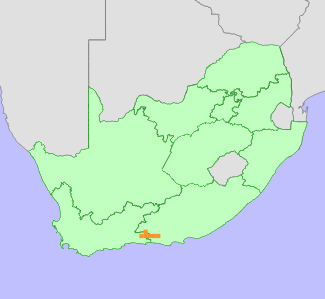|
Scientific Name | Leucadendron sorocephalodes E.Phillips & Hutch. |
Higher Classification | Dicotyledons |
Family | PROTEACEAE |
Common Names | Woolly Conebush (e) |
National Status |
Status and Criteria | Near Threatened A2a; B1ab(iii)+2ab(iii) |
Assessment Date | 2020/06/16 |
Assessor(s) | A.G. Rebelo, H. Mtshali & L. von Staden |
Justification | Leucadendron sorocephalodes is restricted to the mountains of the eastern parts of the Cape Floristic Region (extent of occurrence 1635 km², area of occupancy 172 km²). Unexplained population declines close to 30% have been observed in many subpopulations since 1985 (generation length 15-20 years). The decline may be the result of climate change, as declines tend to be more severe on lower slopes. Monitoring is required to determine whether the population decline is continuing. Furthermore alien invasive plants present in low density may spread and cause future degradation of habitat. This species almost qualifies against the thresholds for Vulnerable under criteria A and B and is assessed as Near Threatened. |
Distribution |
Endemism | South African endemic |
Provincial distribution | Eastern Cape, Western Cape |
Range | This species is endemic to Outeniqua and Baviaanskloof Mountains, in the Eastern and Western Cape provinces of South Africa. |
Habitat and Ecology |
Major system | Terrestrial |
Major habitats | Kouga Grassy Sandstone Fynbos, Kouga Sandstone Fynbos |
Description | It occurs on rocky sandstone slopes, 800-1700 m. This is a short lived species with a generation length of 15-20 years. Mature individuals are killed by fires, and only seeds survive. Seeds are released after ripening, and dispersed by ants to their underground nests, where they are protected from predation and fire. It is dioecious, with insect-pollinated male and female flowers occurring on separate plants. |
Threats |
| Most of this species' habitat falls within protected areas, and there is no significant ongoing habitat loss. As a reseeder, this species is however potentially vulnerable to inappropriate fire management, particularly aseasonal fire increases associated with climate change-related droughts and over burning to enhance vegetation growth for livestock grazing. Recent field observations noted alien invasive plants present in low density in the habitat of several subpopulations. These could outcompete native species in future if left unmanaged.
The have been observed declines to subpopulations and these are attributed to global warming as lowermost portions of subpopulations are declining more (Euston Brown, pers. obs.). |
Population |
Subpopulations of this species are small and naturally fragmented. Population decline of less than 30% has been observed over the past 35 years and is attributed to climate change (generation length 15-20 years).
|
Population trend | Decreasing |
Conservation |
| It is protected within the Baviaanskloof Nature Reserve and Kouga Wilderness Area. |
Assessment History |
Taxon assessed |
Status and Criteria |
Citation/Red List version | | Leucadendron sorocephalodes E.Phillips & Hutch. | NT A2a | Raimondo et al. (2009) | | Leucadendron sorocephalodes E.Phillips & Hutch. | Vulnerable | Hilton-Taylor (1996) | |
Bibliography |
Goldblatt, P. and Manning, J.C. 2000. Cape Plants: A conspectus of the Cape Flora of South Africa. Strelitzia 9. National Botanical Institute, Cape Town.
Hilton-Taylor, C. 1996. Red data list of southern African plants. Strelitzia 4. South African National Botanical Institute, Pretoria.
Manning, J.C. and Goldblatt, P. 2012. Plants of the Greater Cape Floristic Region 1: The Core Cape Flora. Strelitzia 29. South African National Biodiversity Institute, Pretoria.
Raimondo, D., von Staden, L., Foden, W., Victor, J.E., Helme, N.A., Turner, R.C., Kamundi, D.A. and Manyama, P.A. 2009. Red List of South African Plants. Strelitzia 25. South African National Biodiversity Institute, Pretoria.
Rebelo, T. 2001. Sasol Proteas: A field guide to the proteas of southern Africa. (2nd ed.). Fernwood Press, Vlaeberg, Cape Town.
|
Citation |
| Rebelo, A.G., Mtshali, H. & von Staden, L. 2020. Leucadendron sorocephalodes E.Phillips & Hutch. National Assessment: Red List of South African Plants version 2024.1. Accessed on 2025/10/30 |
 Comment on this assessment
Comment on this assessment

